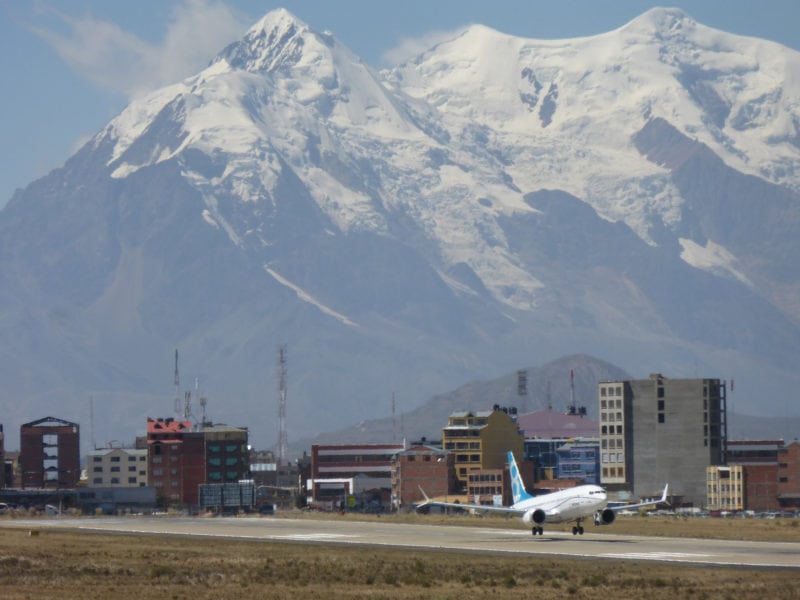
Teledyne Technologies is the sole source provider of data acquisition technology on the Boeing 737 MAX, pictured here performing high altitude flight testing in high altitude flight testing in La Paz, Bolivia last year. Photo: Boeing.
Aircraft information management has evolved from using aircraft data acquisition technology to send system data to Flight Data Recorders (FDR) and into new areas with new interests and potential market opportunities. Teledyne Technologies Senior Vice President of Strategy and Mergers & Acquisitions Jason VanWees talked about how his company is addressing new trends in aircraft information management during an aerospace and defense investment conference in New York on Wednesday.
Aircraft information management for commercial airlines has historically been referred to the use of an aircraft data acquisition system to send data to a crash-hardened FDR, as well as for aircraft maintenance purposes. Over the last two decades, that data was typically saved on a floppy disk. When an aircraft landed, the data would then be sent to the airline’s flight operational and maintenance teams for review. This usually caused a big lag time in terms of how and when operators were able to access their aircraft’s flight operational performance data, review it and use it to anticipate needed parts replacements or simply improve their flight operations based on performance associated with specific routes as well as critical flight events.
Over the last several years, that process has evolved, bringing the commercial airline industry into the 21st century, according to VanWees.
“For the last several years, the data itself has been sent over wireless networks or Wi-Fi depending on the customer, directly to the airlines operations center or some cases now in China to the government as well so they can monitor aircraft,” VanWees said, during his presentation at the Cowen Aerospace/Defense & Industrials Conference.
Flight data acquisition units have been widely used with the floppy-disk method described by VanWees on Airbus and Boeing aircraft for several decades. The units are connected to dozens of databuses, tapping into just about anything that emits data onboard the aircraft, and feeding that into the FDR. Regionally, civil aviation regulatory agencies have differing requirements in terms of how that data is acquired, what data needs to be monitored and who gets access to it. In China for example, VanWees noted that the aviation wing of the government requires Chinese registered aircraft to send that data directly to the government so that it can monitor the aircraft.
In its recent fiscal year 2016 earnings call, Teledyne noted that sales of its data acquisition technology increased by 18 percent last year. The company is also positioning itself to be even stronger on flight-data acquisition technology and providing it for different purposes.
“We’re very, very focused largely on one market, and that’s aircraft information management for air transport aircraft,” VanWees said.
In November 2016, Teledyne signed a partnership agreement with GE Aviation, where the two companies will look to combine the data analytics capabilities of GE’s Predix cloud-based data analysis platform with Teledyne’s GroundLink technology designed to transfer data between aircraft systems and airline back offices. VanWees said the details of the agreement are still being worked out, but it would be a new use of Teledyne’s aircraft data acquisition technology to help GE’s engine customers to get more data about their engine performance faster.
Another trend around aircraft information management, according to VanWees, is a possible market opportunity for real-time data streaming using satellite communications or even broadband technologies.
“If all this data is available for download when an aircraft lands, why aren’t you doing it over satcom in real time?” said VanWees. “I think you probably should, we have the hardware that collects the data anyway, but I think that’s going to be rather slow to adopt.”
The Teledyne executive listed several challenges to widespread adoption of new aircraft data-streaming technology. Primarily, streaming airborne aircraft data in real time is expensive, although VanWees noted new High Throughput Satellites (HTS) could help bring that cost down. While there are already airlines that are streaming data from FDRs in real time, such as First Air, which became the first carrier to do so in 2014, VanWees says as more companies figure out ways to lessen the costs of such an operation, expect to see more demand for it from commercial carriers.
“An airline will have to say well what’s the use of all this data for a very expensive transponder? Do I really want every single piece of data sucking up transponder bandwidth while in flight, or do I just get it when I land on the ground? And I don’t know the answer to that question. I hope it’s sooner rather than later, because that’s potentially more demand for our hardware,” he said.